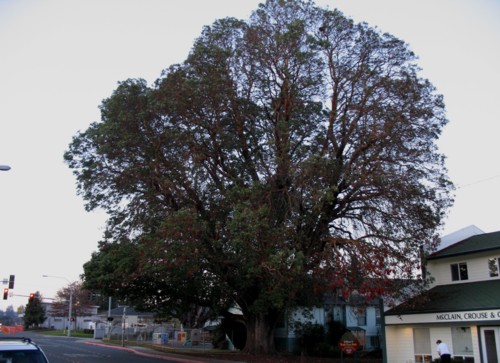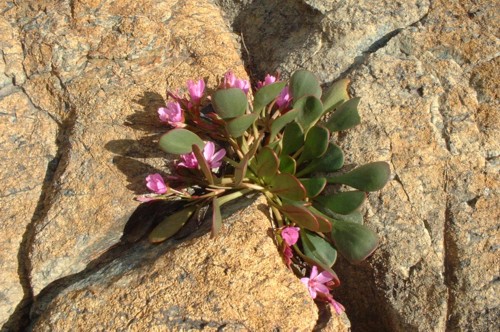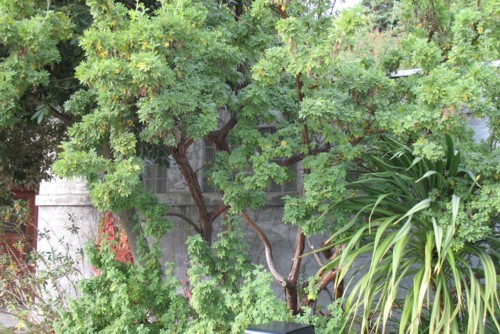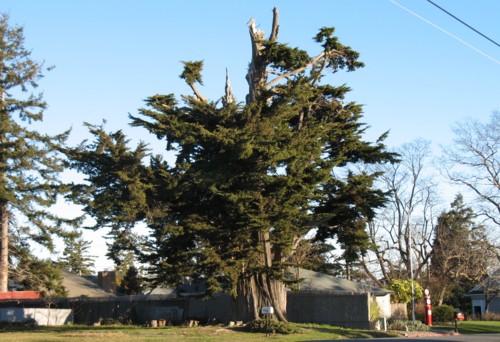|
2008 Plant Photo of the Month Archive
|

Plants and Gardens Gallery |
|
Port Angeles is an interesting city. Built on a north facing slope sliced through with deep ravines, it enjoys a rather dry but perpetually cool and often foggy climate. Protruding farther northwest than any other large city in the state, it has the feel of a rather sea-going, fishy sort of place: the word 'maritime' practically floats on the air. Although rich with history, the city does seem to exhibit somewhat of an economic let-down, as it has never been connected to the rest of the world by rail, and as with many rural northwestern cities, the decline of the early logging industry didn't help. In a place this big, with so much history, one is bound to find some interesting plants. I have found some impressively large eucalypts there. Most notably, the city is full of madronas (Arbutus menziesii), the largest of which also happens to be the largest known anywhere in the world. It is only marginally the holder of this title, though: some trees on Saltspring Island, BC come very close to it in size, and perhaps a larger one remains to be found. Madrona is perhaps the Pacific Northwest's most special native tree, being the largest member of the heath family (Ericaceae) and by far the most prominent native broadleaf evergreen tree in Washington and British Columbia. Making it even more special is the fact it really only likes to grow here - outside of its native range, it is very fussy and difficult to maintain. It seems to require our cool, dry summers and dank winters to thrive. This rather dark picture (I apologize for the poor lighting) shows the world's largest known madrona tree, on 8th street in Port Angeles. Maybe someday I can go back and photograph it in its full glory on a sunny day. |
|
|
Who says native plants aren't cool? Actually, few of us would, and that's a good thing. While some native plants deserve wider use for practicality's sake, others have great ornamental worth but are downright challenging. This would be an example of the latter type. Claytonia megarhiza var. nivalis, photographed here near Ingalls Lake in the Mt. Stuart area of the Cascades, is a perennial succulent member of the Portulaceae family, along with Lewisia. It has a reputation for being very difficult, though not impossible, in cultivation. As seen here, it is often found growing in cracks in large rocks in the wild, a situation that can't be easy to replicate unless you're a serious rock gardener. Still, one has to try. Mt. Tahoma Nursery seems to usually offer this plant. Maybe someday I'll figure out how to grow it myself. |
|
|
To me this is one of those plants that looks appealing and different, but it's hard to put into words exactly why I feel that way about it. The irregular habit, soft textured pinnately compound leaves, and fibrous brown bark come together to produce a beautiful plant by what seems an improbable combination of features. A large shrub or small tree, Leucosidea sericea is well adapted to milder Seattle gardens, yet almost never seen here. This example is from the Carl S. English, Jr. Botanic Gardens at the Ballard Locks and is actually the only one I know of planted out anywhere in the Pacific Northwest. Coming from moist areas in the mountains of South Africa, it is in the Rosaceae family and seems to exhibit some alliance to such interesting genera as Polylepis and Lyonothamnus. It is easy to grow and I should be able to have it available frequently. |
|
|
Here's an example of a conifer that's certainly hardy in milder parts of the Northwest, but for whatever reason it is almost never encountered in nurseries or gardens. The Monterey cypress, Cupressus macrocarpa, is native to a small strip of the central California coast around Monterey, where its picturesque, wind-shaped habit recalls many a familiar postcard picture. The specimen pictured is one of two age-old plants in Port Townsend. Other, mostly smaller examples can be seen in Seattle, Bremerton, and Vashon Island, as well as one very large one on Fox Island. It is unlikely to perform as well in colder inland gardens. Although a beautiful tree, it can get large and should only be planted in gardens that have enough space to accomodate it. |
|
|
|
|
|
|
|
|
|
|
|
|
|
|
|
|
|
|
|
|
|
|
|
|
|



